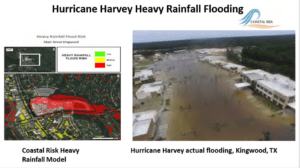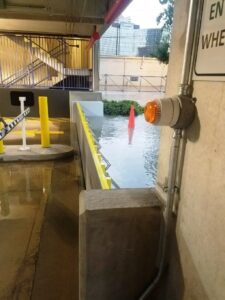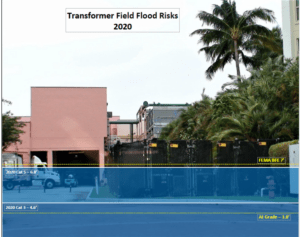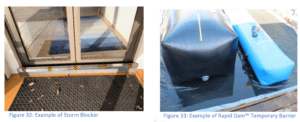This GUEST ARTICLE for REVITALIZATION was written by Albert J. Slap.
On June 30, 2020, the Florida Legislature enacted a new law that prohibits state-financed construction of certain structures in coastal areas after a specified date, without first taking certain steps regarding a sea level impact projection study. It takes effect on July 1, 2021.
According to the new law, Florida Department of Environmental Protection (DEP) would not be able to issue the new rule on sea level rise studies until after July 1, 2021, and, the new law delays required compliance for 1-year after that. So, while quite laudatory in its scope and purpose, any compliance with this law will be delayed until well after July 2022. During this time, however, the Florida DEP’s professionals will do their best to develop a rule to implement the law’s requirements.
To me, the real question, here, is not so much the law’s impact on state-funded, coastal buildings several years from now, but, what salutary effects this law may have on the development of commercial and multi-family buildings in the coastal areas of Florida over the next two plus years.
Most of what is built in the coastal areas of Florida, and will continue to be built, are private, not public, buildings. So, looking at the new law, we can examine its contents and its implicit direction to private real estate developers, public and private investors, lenders, and tenants.
The new law creates a new term, the “SLIP study”. A “SLIP” study means a sea level impact projection study, as established by the DEP, pursuant to subsection (3). While the Florida DEP will, no doubt, do an excellent job creating the contents of the SLIP study and the final rule, what is notable is that DEP already funds sea level rise vulnerability and adaptation studies for local governments.
There is no “one rule” for these DEP-funded studies, but, as a Company that performs these studies for local governments and has studied what Florida local governments have done in the past, I can report, unequivocally, that Florida DEP is doing a great job helping local governments study their risks, their vulnerabilities and potential adaptation solutions.
According to this new law, beginning 1-year after the date the rule developed by the Department, a state-financed constructor may not commence construction of a coastal structure without: (a) Conducting a SLIP study that meets the requirements established by the Department; (b) Submitting the study to the Department; and, (c) Receiving notification from the Department that the study was received and that it has been published on the Department’s website pursuant to paragraph (6)(a) for at least 30 days.
The DEP Slip Study rule must be effective 1-year after the date it is finalized and applies only to projects not yet commenced as of the date the rule is finalized. The rule may not apply retroactively to projects that commenced before the date the rule is finalized.
The new SLIP study will require the constructor using state funds to: (a) Use a systematic, interdisciplinary, and scientifically accepted approach in the natural sciences and construction design in conducting the study; and, (b) Assess the flooding, inundation, and wave action damage risks relating to the coastal structure over its expected life or 50 years, whichever is less.
The use of the 50-year study period is very important, not only for public buildings, but for privately-owned buildings, as well. While a private developer may be flipping the building to a condo HOA, a REIT, or Private Equity fund, the building will likely still be around in 30-50 years and will be subject to all of the climate changes present at that time.
Furthermore, the SLIP assessment must take into account potential relative local sea-level rise and increased storm risk during the expected life of the coastal structure or 50-years, whichever is less, and, to the extent possible, account for the contribution of sea-level rise versus land subsidence to the relative local sea-level rise. The assessment must also, inter alia:
- Provide scientific and engineering evidence of the risk to the coastal structure and methods used to mitigate, adapt to, or reduce this risk;
- Consider available scientific research and generally accepted industry practices;
- Provide the mean average annual chance of substantial flood damage over the expected life of the coastal structure or 50 years, whichever is less;
- Analyze potential public safety and environmental impacts resulting from damage to the coastal structure, including, but not limited to, leakage of pollutants, electrocution and explosion hazards, and hazards resulting from floating or flying structural debris; and
- Provide alternatives for the coastal structure’s design and siting, and how such alternatives would impact the risks specified in the law, as well as the risk and cost associated with maintaining, repairing, and constructing the coastal structure.
Finally, the new Florida law admonishes that, if a state-financed constructor commences construction of a coastal structure but has not complied with the SLIP study requirement under subsection (2), the Department may institute a civil action in a court of competent jurisdiction to: (a) Seek injunctive relief to cease further construction of the coastal structure or enforce compliance with this section or with rules adopted by the department pursuant to this section; and, (b) If the coastal structure has been completed or has been substantially completed, seek recovery of all or a portion of state funds expended on the coastal structure.
While this new law (requiring Sea Level Rise SLIP studies before embarking on public funding of buildings in coastal Florida) will someday begin to make such buildings safer and more resilient to climate changes, its most valuable, near-term effect may be to accelerate these exact same studies and practices within the commercial and multi-family real estate development community, especially in the fast-paced, Florida coastal markets.
Some more progressive REITs and commercial real estate companies are beginning to take these steps voluntarily. For example, a major firm recently engaged Coastal Risk to examine sea level rise, flooding, and climate change risks at a historic hotel/resort in South Florida. Putting such a large property (with many buildings of different vintages, some over 100-years old) under a “risk mitigation microscope” was a challenge.
Coastal Risk’s world-class team included climate scientists, engineers, architects, storm water and flood mitigation experts. After careful modeling of tidal flooding, sea level rise, storm surge, and future extreme heat and rainfall, specific recommendations were provided to the client.
These included such measures as: elevating new construction, raising seawalls, investing in new, more efficient AC chillers, installing larger roof drains to move rainwater faster off flat surfaces, installing hurricane-proof glass in some locations, doorway barriers, dry floodproofing, re-grading and stormwater controls, and greater flood protections for utilities, such as electrical, backup generators, and communications equipment.
Another company partnering with Coastal Risk to assess risks to properties is American Realty Advisors. Said Don Pecano, Vice President Due Diligence at ARA, “ARA has been increasingly interested in more fully understanding physical risks to our assets from floods, natural hazards and climate impacts as part of our overall Corporate Responsibility and Sustainability Program. We have worked closely with Coastal Risk to identify and dimension those risks for our existing portfolio and during the due diligence process for new investments.”
All photos courtesy of Albert J. Slap.
About the Author:
 Albert J. Slap is President and Co-Founder of Coastal Risk Consulting, LLC, a geospatial technology, modeling and data analytics company located in Boca Raton, FL. Coastal Risk’s technology empowers individuals, businesses and governments in the US and globally to accelerate resilience to floods, natural hazards and climate impacts. Coastal Risk provides the robust tools needed for informed, resilience decision-making, today, and decades into the future.
Albert J. Slap is President and Co-Founder of Coastal Risk Consulting, LLC, a geospatial technology, modeling and data analytics company located in Boca Raton, FL. Coastal Risk’s technology empowers individuals, businesses and governments in the US and globally to accelerate resilience to floods, natural hazards and climate impacts. Coastal Risk provides the robust tools needed for informed, resilience decision-making, today, and decades into the future.
Prior to launching Coastal Risk, Mr. Slap was a nationally recognized, environmental trial attorney and law professor. Over the years, Mr. Slap used America’s environmental laws and its legal system to protect public health and the environment by stopping water and air pollution, toxic waste dumping, and by requiring local governments to replace aging and polluting sewer infrastructure. His Clean Water Act citizen suits delivered cleaner rivers and streams and brought billions of dollars of re-investment in municipal wastewater treatment plants, thereby creating tens of thousands of new construction jobs.
Mr. Slap has authored numerous legal articles and book chapters on environmental issues and has been an invited speaker at dozens of legal, environmental, insurance, and commercial real estate conferences. He has served as a Board Member of The Nature Conservancy’s Pennsylvania Chapter, Director of The Nature Conservancy’s Colorado River Program and a member of The Nature Conservancy’s Caribbean Advisory Board (www.nature.org). Mr. Slap was also was a Board Member and General Counsel of Friends of the Everglades. For his outstanding legal work, Mr. Slap was the recipient in 2014 of the prestigious Marjory Stoneman Douglas “Defender of the Everglades Award.”
See Albert Slap’s blog.






